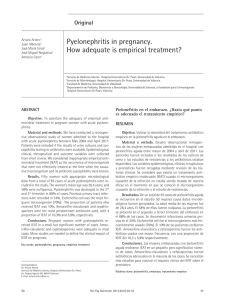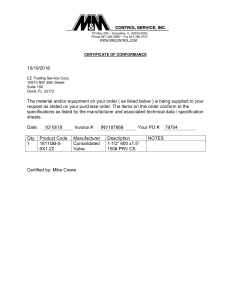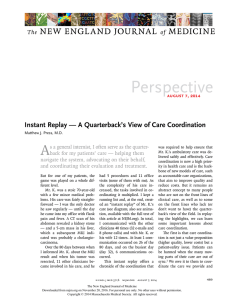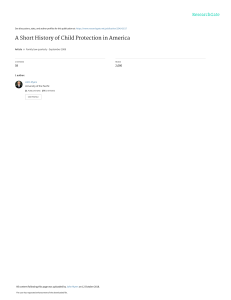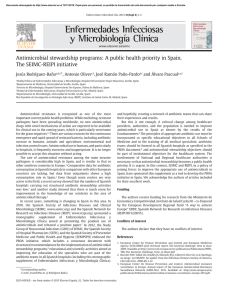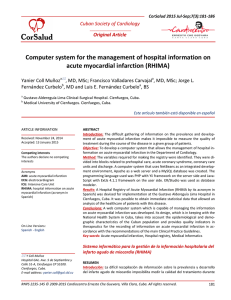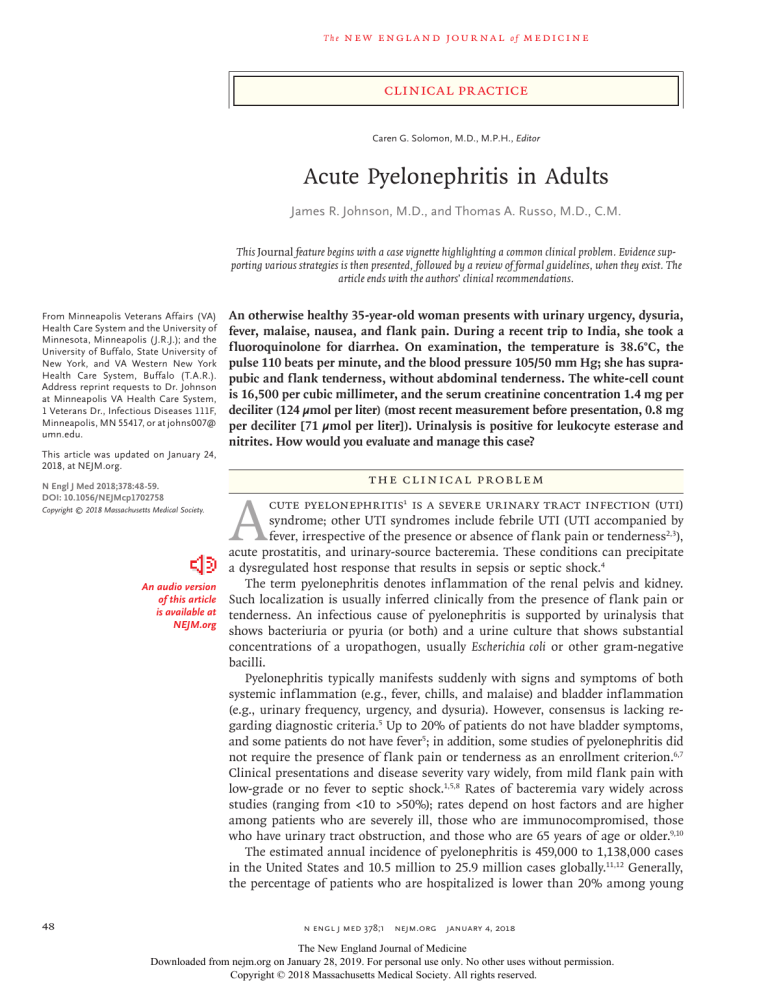
The n e w e ng l a n d j o u r na l of m e dic i n e Clinical Practice Caren G. Solomon, M.D., M.P.H., Editor Acute Pyelonephritis in Adults James R. Johnson, M.D., and Thomas A. Russo, M.D., C.M. This Journal feature begins with a case vignette highlighting a common clinical problem. Evidence supporting various strategies is then presented, followed by a review of formal guidelines, when they exist. The article ends with the authors’ clinical recommendations. From Minneapolis Veterans Affairs (VA) Health Care System and the University of Minnesota, Minneapolis (J.R.J.); and the University of Buffalo, State University of New York, and VA Western New York Health Care System, Buffalo (T.A.R.). ­Address reprint requests to Dr. Johnson at Minneapolis VA Health Care System, 1 Veterans Dr., Infectious Diseases 111F, Minneapolis, MN 55417, or at ­johns007@ ­umn.­edu. This article was updated on January 24, 2018, at NEJM.org. N Engl J Med 2018;378:48-59. DOI: 10.1056/NEJMcp1702758 Copyright © 2018 Massachusetts Medical Society. An audio version of this article is available at NEJM.org 48 An otherwise healthy 35-year-old woman presents with urinary urgency, dysuria, fever, malaise, nausea, and flank pain. During a recent trip to India, she took a fluoroquinolone for diarrhea. On examination, the temperature is 38.6°C, the pulse 110 beats per minute, and the blood pressure 105/50 mm Hg; she has suprapubic and flank tenderness, without abdominal tenderness. The white-cell count is 16,500 per cubic millimeter, and the serum creatinine concentration 1.4 mg per deciliter (124 μmol per liter) (most recent measurement before presentation, 0.8 mg per deciliter [71 μmol per liter]). Urinalysis is positive for leukocyte esterase and nitrites. How would you evaluate and manage this case? A The Cl inic a l Probl em cute pyelonephritis1 is a severe urinary tract infection (UTI) syndrome; other UTI syndromes include febrile UTI (UTI accompanied by fever, irrespective of the presence or absence of flank pain or tenderness2,3), acute prostatitis, and urinary-source bacteremia. These conditions can precipitate a dysregulated host response that results in sepsis or septic shock.4 The term pyelonephritis denotes inflammation of the renal pelvis and kidney. Such localization is usually inferred clinically from the presence of flank pain or tenderness. An infectious cause of pyelonephritis is supported by urinalysis that shows bacteriuria or pyuria (or both) and a urine culture that shows substantial concentrations of a uropathogen, usually Escherichia coli or other gram-negative bacilli. Pyelonephritis typically manifests suddenly with signs and symptoms of both systemic inflammation (e.g., fever, chills, and malaise) and bladder inflammation (e.g., urinary frequency, urgency, and dysuria). However, consensus is lacking regarding diagnostic criteria.5 Up to 20% of patients do not have bladder symptoms, and some patients do not have fever5; in addition, some studies of pyelonephritis did not require the presence of flank pain or tenderness as an enrollment criterion.6,7 Clinical presentations and disease severity vary widely, from mild flank pain with low-grade or no fever to septic shock.1,5,8 Rates of bacteremia vary widely across studies (ranging from <10 to >50%); rates depend on host factors and are higher among patients who are severely ill, those who are immunocompromised, those who have urinary tract obstruction, and those who are 65 years of age or older.9,10 The estimated annual incidence of pyelonephritis is 459,000 to 1,138,000 cases in the United States and 10.5 million to 25.9 million cases globally.11,12 Generally, the percentage of patients who are hospitalized is lower than 20% among young n engl j med 378;1 nejm.org January 4, 2018 The New England Journal of Medicine Downloaded from nejm.org on January 28, 2019. For personal use only. No other uses without permission. Copyright © 2018 Massachusetts Medical Society. All rights reserved. Clinical Pr actice Key Clinical Points Acute Pyelonephritis • • • • • Acute pyelonephritis has the potential to cause sepsis, septic shock, and death. Urine culture is the cardinal confirmatory diagnostic test. Imaging is recommended at the time of presentation for patients with sepsis or septic shock, known or suspected urolithiasis, a urine pH of 7.0 or higher, or a new decrease in the glomerular filtration rate to 40 ml per minute or lower. Subsequent imaging is indicated in patients whose condition worsens or does not improve after 24 to 48 hours of therapy. The rising prevalence of Escherichia coli resistant to fluoroquinolones and trimethoprim–sulfamethoxazole complicates empirical oral therapy. In patients who receive oral treatment from the outset, depending on the likelihood of resistance, an initial dose of a supplemental, long-acting, parenteral antimicrobial agent (e.g., an aminoglycoside, ceftriaxone, or ertapenem) may be appropriate, and close follow-up is warranted. Assessment of illness severity, underlying host status, and the patient’s psychosocial situation and estimation of the likelihood of pathogen resistance to relevant antimicrobial agents are critical in decisions regarding patient disposition and treatment. women but higher among young children and adults older than 65 years of age. A total of 712 deaths were attributed to kidney infection in the U.S. National Vital Statistics Reports for 2014,13 but 38,940 deaths were attributed to septicemia; on the basis of a conservative estimate that 10% of septicemia cases originate from pyelonephritis, there may be nearly 4000 deaths from pyelonephritis annually.14 The total (direct and indirect) estimated cost related to pyelonephritis in the United States was $2.1 billion (in year 2000 dollars),15 but the use of observation units has decreased the rate of admissions for pyelonephritis and presumably the costs.16 Risk factors for cystitis (e.g., sexual activity, new sexual partner, spermicide exposure, and personal history or maternal history of UTI) also confer a predisposition to pyelonephritis,17 although 3% or less of cases of cystitis and asymptomatic bacteriuria progress to pyelonephritis.18 Factors that impede urine flow (e.g., pregnancy or mechanical obstruction) increase this risk. Other risk factors probably include a genetic predisposition (e.g., altered innate immunity from low CXCR1 expression), a high microbial load, pathogen virulence attributes (e.g., adhesins such as P fimbriae), and possibly diabetes mellitus.19 Pyelonephritis usually occurs when enteric bacteria enter the bladder and ascend to the kidneys.20 Rarely, organisms such as Staphylococcus aureus or candida seed the kidneys hematogenously. Few data document the natural history of untreated pyelonephritis. In one study, among n engl j med 378;1 14 women who received an antibiotic to which the pathogen was resistant, 5 (36%) had a clinical cure — a finding that suggests either spontaneous clearance or partial antibiotic effectiveness despite in vitro resistance.21 With appropriate care, clinical manifestations usually decrease progressively, as shown by a reduction in symptoms and downward trends in the fever curve and white-cell count; however, resolution may require up to 5 days.22 Worsening or no improvement by 24 to 48 hours arouses concern for potential complications that may warrant urgent intervention. These complications include obstruction (more likely with urolithiasis, tumors, sickle cell disease, or diabetes), renal or perinephric abscess (often caused by obstruction), and emphysematous pyelonephritis (a rare, necrotizing, gas-forming infection associated with diabetes).23 Mild acute kidney injury from inflammationrelated hemodynamic shifts is common and resolves quickly with treatment. Advanced renal failure is rare in the absence of coexisting urinary tract obstruction. Recurrent pyelonephritis is relatively uncommon (recurrence rate of <10%) and suggests a possible predisposing condition.12 Patho gens Among young healthy women, specific virulent clones of E. coli account for more than 90% of pyelonephritis cases.20 In contrast, among men, elderly women, and urologically compromised or institutionalized patients, less-virulent E. coli strains, non–E. coli gram-negative bacilli, gram- nejm.org January 4, 2018 The New England Journal of Medicine Downloaded from nejm.org on January 28, 2019. For personal use only. No other uses without permission. Copyright © 2018 Massachusetts Medical Society. All rights reserved. 49 The n e w e ng l a n d j o u r na l positive organisms, and candida are more prevalent, although infections with E. coli still predominate.1 Emerging antimicrobial resistance is attributable largely to the epidemic spread of highly successful E. coli clones, most notably the H30 subset within sequence type ST131.24 S t r ategie s a nd E v idence Diagnosis In a patient with flank pain or tenderness (with or without fever) plus a urinalysis showing pyuria, bacteriuria, or both (with or without voiding symptoms), pyelonephritis is an appropriate presumptive diagnosis. Other causes of flank pain or tenderness, with or without fever, include acute cholecystitis, appendicitis, urolithiasis, paraspinous muscle disorders, renal-vein thrombosis, and pelvic inflammatory disease. In men, fever plus pyuria, bacteriuria, or both, but without flank pain or tenderness, suggests possible prostatitis. The cardinal confirmatory test is the urine culture, which typically yields 10,000 or more colony-forming units of a uropathogen per milliliter of urine.1,25 Lower counts may be present if the patient had received previous antimicrobial therapy, has extreme urine acidification, or has urinary tract obstruction.26 Positive blood cultures may assist in establishing a diagnosis in ambiguous cases (e.g., in populations with a high prevalence of asymptomatic bacteriuria or in patients who have received previous antimicrobial therapy), but the presence of bacteremia rarely alters management.9,27 Initial imaging to identify obstruction, abscess, or necrotizing infection is reserved for patients with sepsis or septic shock, known or suspected urolithiasis, a urine pH of 7.0 or higher, or a new decrease in the glomerular filtration rate to 40 ml per minute or lower (which is suggestive of obstruction).10,28 Treatment Assessment of illness severity, coexisting medical conditions, and psychosocial status allows for initial triage to one of three disposition options (Table 1 and Fig. 1). One option is direct discharge to home (with or without a fluid bolus or a parenteral dose of a long-acting, broaderspectrum agent) (Table 2 and Fig. 2); this option is appropriate for mildly ill patients who have minimal nausea, no vomiting, stable coexisting 50 n engl j med 378;1 of m e dic i n e medical conditions, a reliable psychosocial situation, and a suitable empirical oral antimicrobial option. A second option is extended care in the emergency department or observation unit for more extensive resuscitation and initial intravenous antimicrobial therapy; this option is appropriate for patients who are initially unable or unwilling to swallow an oral agent, seem too ill to go home immediately, or have clinically significant hypovolemia. This option allows deferral of hospital admission decisions, pending the outcome of initial therapy. Abundant evidence supports the suitability of such discharge-based strategies for appropriately selected patients.29 In contrast, immediate hospital admission — the third option — is warranted for patients who have severe illness, unstable coexisting medical conditions, an unreliable psychosocial situation, or no acceptable oral therapy option. The three pillars of pyelonephritis management are supportive care, antimicrobial therapy, and source control. Each is described in detail below. Supportive Care Fluid resuscitation can reduce malaise, nausea, and vomiting. Thus, patients who are discharged directly home may benefit from an initial intravenous fluid bolus, patients who are cared for initially in the emergency department warrant more extensive fluid therapy, and patients who are admitted to the hospital directly because of sepsis or septic shock should receive aggressive fluid resuscitation (e.g., 30 ml of isotonic crystalloid per kilogram of body weight within a 3-hour period) and possibly vasopressor drugs.30 Medications to control symptoms, such as analgesics, antipyretics, and antinausea agents, should be used as needed. Initial Antimicrobial Therapy Effective antimicrobial therapy should be initiated promptly. Efficacy is dependent on the delivery of a drug in adequate concentrations to the site of infection (renal tissue, blood, or both — not just the urine); the drug should be predictably active against the infecting organism, should have proven clinical efficacy for pyelonephritis, and should not be contraindicated by allergies or drug–drug interactions. Nitrofurantoin and oral fosfomycin attain adequate concentrations only in the urine and thus should be nejm.org January 4, 2018 The New England Journal of Medicine Downloaded from nejm.org on January 28, 2019. For personal use only. No other uses without permission. Copyright © 2018 Massachusetts Medical Society. All rights reserved. Clinical Pr actice Table 1. Triage and Management Considerations for Initial Disposition of Patients with Acute Pyelonephritis or Febrile Urinary Tract Infection. Aspect of Care Disposition of Patients Immediate Discharge to Home Initial Management in Emergency Department or Observation Unit Immediate Hospital Admission Triage Initial illness severity Suitability of oral therapy Coexisting medical conditions* Psychosocial situation* Mild, no vomiting Moderate, with or without vomiting Yes; intravenous dose before discharge is optional Sepsis or critical modifying factors* Yes, after initial intravenous dose or doses No None or stable None or stable Potentially unstable or critical* Stable Stable Potentially unstable or critical* Moderate resuscitation, with or without maintenance Vigorous resuscitation None None May need one or more of the following: a vasopressor, supplemental oxygen, and invasive or noninvasive mechanical ventilation Intravenous, oral, or both Intravenous, oral, or both Intravenous, oral, or both Supportive care Fluid resuscitation Cardiopulmonary Medications for symptoms† None or minor resuscitation Delivery of antimicrobial agent Oral Prescription at or before dis- Before discharge from the emergency Defer until patient’s condition is charge from the emergency department or observation unit, ­stabilized in hospital department or observation if sent home unit Intravenous Single dose, if needed Immediate dose; can readminister in the emergency department or observation unit Immediate administration; continue in hospital Source control Imaging None If at risk for obstruction, abscess, or If at risk for obstruction, abscess, or emphysematous pyelonephritis‡ emphysematous pyelonephritis‡ Urologic evaluation or inter­ ventional radiology None If undrained focus discovered Urgent, if undrained focus discovered *Modifying factors include coexisting medical conditions and psychosocial situation. Hospital admission may be warranted even with mild or moderately severe illness if the patient has one or more unstable or severe coexisting conditions (e.g., cardiac, pulmonary, or psychiatric), an unreliable home situation, or other factors that reduce the likelihood of adherence to home therapy or of reaccessing care in case of clinical worsening at home. †Medications for symptoms include antiemetics (e.g., prochlorperazine and ondansetron), analgesics (e.g., opiates and acetaminophen), anti­ inflammatory drugs (e.g., ibuprofen), and urinary anesthetics (e.g., phenazopyridine). ‡Risk factors for or predictors of urinary tract obstruction and renal or perinephric abscess include known or suspected urolithiasis, a urine pH of 7.0 or higher, a new decrease in the estimated glomerular filtration rate to 40 ml per minute or lower, unexplained oliguria, septic shock, worsening clinical status despite aggressive medical therapy, and sickle cell disease. Emphysematous pyelonephritis should be suspected if the patient has diabetes plus septic shock, worsening clinical status despite aggressive medical therapy, or known or suspected urinary tract obstruction. avoided. In contrast, fluoroquinolones and trimethoprim–sulfamethoxazole, if active against the pathogen, are highly efficacious.29 These agents attain high concentrations in the urine and renal tissue, have an acceptable side-effect profile, and have performed excellently (e.g., rate of clinical success, ≥90%) in clinical trials.2,3,29,31 The choice of empirical antibiotic therapy is guided by estimates of the likelihood of a resistant organism (as estimated on the basis of epin engl j med 378;1 demiologic data and individual patient risk factors for resistance) and by an assessment of whether the patient will have an adverse outcome if the treatment is inadequate (temporarily) because of a resistant organism. Antimicrobial resistance is a growing problem; the prevalence of resistance to trimethoprim–sulfamethoxazole and fluoroquinolones among E. coli isolates exceeds 10% in most surveys.1 The 2011 guidelines regarding pyelonephritis from the Infectious nejm.org January 4, 2018 The New England Journal of Medicine Downloaded from nejm.org on January 28, 2019. For personal use only. No other uses without permission. Copyright © 2018 Massachusetts Medical Society. All rights reserved. 51 The n e w e ng l a n d j o u r na l of m e dic i n e Acute Pyelonephritis Indication for initial genitourinary imaging? New eGFR decrease to ≤40 ml per minute Known or suspected urolithiasis Urine pH ≥7.0 No Yes Clinical indication for immediate hospital admission? Sepsis or septic shock Fragile condition Immunocompromise Unstable or severe coexisting conditions Tenuous psychosocial situation No suitable oral antibiotic option Imaging shows need for drainage procedure? No Yes Yes No Admit to hospital Drainage, if indicated by imaging IV antibiotics IV fluids ICU, if sepsis or septic shock is present Medications for symptom relief Indication for ED or observation unit stay? Clinically significant hypovolemia Moderately ill Nausea or vomiting Yes No Treat initially in ED or observation unit IV antibiotics Fluids Medications for symptom relief Yes Discharge to home with oral antibiotic (with or without initial supplemental dose of suitable long-acting, broad-spectrum agent) No Persisting indication for admission after ED or observation unit stay? Ongoing nausea or vomiting Ongoing need for hydration Ongoing hemodynamic instability Patient too ill or unwilling to go home Figure 1. Suggested Management of Acute Pyelonephritis in Adults. The algorithm presumes that a working diagnosis of acute pyelonephritis has been established on the basis of an appropriate combination of symptoms, physical findings, and urinalysis results. A tenuous psychosocial situation (one of the indications for immediate hospital admission) that may affect the success of outpatient therapy includes an unreliable home situation or other factors that reduce the likelihood of adherence to therapy or of reaccessing care in case of clinical worsening. An oral antibiotic may not be suitable because of, for example, anticipated resistance, drug allergy, drug–drug interactions, coexisting medical conditions, or patient refusal. ED denotes emergency department, eGFR estimated glomerular filtration rate, ICU intensive care unit, and IV intravenous. Diseases Society of America (IDSA) recommend among local uropathogens is less than 10%.29 empirical therapy with a fluoroquinolone if the Unfortunately, local susceptibility data may be prevalence of resistance to fluoroquinolones unavailable or may not be derived from a relevant 52 n engl j med 378;1 nejm.org January 4, 2018 The New England Journal of Medicine Downloaded from nejm.org on January 28, 2019. For personal use only. No other uses without permission. Copyright © 2018 Massachusetts Medical Society. All rights reserved. Clinical Pr actice patient population (e.g., inpatients vs. outpatients). Moreover, certain patient-specific factors (e.g., recent hospitalization or antibiotic use) increase the risk of resistance (Fig. 2).1 Furthermore, a resistance threshold of 10% or less, as recommended by the IDSA guidelines, may be too lenient if patients are critically ill, fragile (including having marginal or tenuous organ-system function), or immunocompromised or if they have a tenuous home situation, given the greater risk of bad outcomes if initial treatment is ineffective (Figs. 1 and 2). Under these circumstances, empirical monotherapy with a fluoroquinolone or trimethoprim–sulfamethoxazole is inadvisable. Conversely, for otherwise healthy patients with mild illness and a stable psychosocial situation, a higher resistance threshold could be acceptable, and empirical treatment with a fluoroquinolone or trimethoprim–sulfamethoxazole should be considered. Oral extended-spectrum cephalosporins (and, where available, pivmecillinam) may offer more reliable in vitro susceptibility than fluoroquinolones or trimethoprim–sulfamethozazole but have lower bioavailability, and evidence supporting their use for pyelonephritis is limited.32-34 Accordingly, patients who are discharged immediately home with instructions to take an empirical oral agent should receive an initial supplemental dose of a broader-spectrum, longacting parenteral agent (e.g., ceftriaxone, gentamicin, amikacin, or ertapenem) (Table 2) if the anticipated likelihood of resistance to the oral agent (estimated on the basis of local susceptibility data, if available, and patient-specific factors) exceeds whatever resistance threshold best suits the individual patient (Fig. 2). For example, for an otherwise healthy woman with mild pyelonephritis, a suitable patient-specific resistance threshold might be 15% rather than 10%. If the patient’s estimated likelihood of having a fluoroquinolone-resistant pathogen is 20% (which exceeds the 15% threshold) and fluoroquinolone therapy is planned, a long-acting supplemental drug should be given. Similarly, patients cared for initially in the observation unit or hospital should receive one or more of such broad-spectrum parenteral agents. testing are returned require close follow-up to confirm that their condition has improved. When culture results are available, resistance to the selected oral agent should prompt substitution of an active agent. When a suitable oral option is not available, outpatient intravenous therapy or hospital admission is appropriate. Hospitalized patients who are discharged after the results of susceptibility testing are returned can receive a suitable oral agent, if available, or intravenous therapy to be administered at home.35 Clinical worsening or lack of any improvement after 1 to 2 days of antibiotic therapy mandates repeat urine culture and imaging (see below) to identify whether an obstruction or other anatomical complication is the reason for the lack of clinical improvement. For patients who are cared for as outpatients, a lack of improvement over this time also warrants the administration (or readministration) of a broad-spectrum agent, including possibly intravenous therapy to be administered at home.35 Duration of Therapy Multiple trials of treatments in men and women support several conclusions regarding the duration of therapy. First, among women who have susceptible pathogens, the rates of clinical success are high (>90%) with a 5-to-7-day course of a fluoroquinolone or aminoglycoside or a 14-day course of trimethoprim–sulfamethoxazole.2,6,21,29,31,36-39 Second, among women, in vitro resistance predicts an unacceptable failure rate.21 Third, among men with febrile UTI (i.e., fever plus bacteriuria or pyuria, with or without flank pain or tenderness or overt prostatitis), one third of whom have clinical pyelonephritis,3 the cure rates with ciprofloxacin among those with a susceptible pathogen are approximately as high with 14 days of therapy as with 28 days of therapy 3 and are only marginally lower with 7 days of therapy.2 Fourth, on the basis of limited data from women with pyelonephritis, 10 to 14 days of therapy with extended-spectrum cephalosporins and mecillinam–pivmecillinam may suffice.7,32-34,38,39 Data are lacking on the most effective treatment durations in cases involving severe disease, delayed treatment response, mechanical intervenMonitoring of Effectiveness of Therapy tions (including those for hydroureter, stones, Patients discharged with instructions to take an abscesses, or necrotizing infection), or other oral agent before the results of susceptibility antimicrobial agents. n engl j med 378;1 nejm.org January 4, 2018 The New England Journal of Medicine Downloaded from nejm.org on January 28, 2019. For personal use only. No other uses without permission. Copyright © 2018 Massachusetts Medical Society. All rights reserved. 53 54 n engl j med 378;1 nejm.org January 4, 2018 The New England Journal of Medicine Downloaded from nejm.org on January 28, 2019. For personal use only. No other uses without permission. Copyright © 2018 Massachusetts Medical Society. All rights reserved. Piperacillin–tazobactam, 3.375 g (3 g of piperacillin and 0.375 g of taxobactam) to 4.5 g (4 g of piperacillin and 0.5 g of taxobactam) every 6 hours Penicillins Intravenous* Cefpodoxime, 200 mg twice daily Cefixime, 400 mg daily 10–14 10–14 10–14 Gram-negative bacilli, enterococci Gram-negative bacilli Gram-negative bacilli Gram-negative bacilli Enterococci, some gramnegative bacilli Gram-negative bacilli Active against some cephalosporin-resistant gram-negative bacilli Active against many fluoroquinolone-resistant and trimethoprim– sulfamethoxazole-resistant gram-negative bacilli; little clinical evidence available Active against many fluoroquinolone-resistant and trimethoprim– sulfamethoxazole-resistant gram-negative bacilli; little clinical evidence available Unavailable in the United States Administer if the pathogen is likely to be enterococcus; not for empirical monotherapy Because of possible resistance, initial intravenous administration of a supplemental drug is often warranted Because of possible resistance, initial intravenous administration of a supplemental drug is often warranted Because of possible resistance, initial intravenous administration of a supplemental drug is often warranted Because of possible resistance, initial intravenous administration of a supplemental drug is often warranted Comment B B B B B C C C C of Cephalosporins 10–14 10–14 10–14 Gram-negative bacilli Gram-negative bacilli Gram-negative bacilli Spectrum of Activity Safety of Use during Pregnancy† n e w e ng l a n d j o u r na l Pivmecillinam, 400 mg 2 times daily Amoxicillin–clavulanate, 875 mg of amoxicillin and 125 mg of clavulanate, 2 times daily Penicillins Trimethoprim–sulfamethoxazole, 160 mg of trimethoprim and 800 mg of sulfamethoxazole, twice daily Antifolate drugs 5 7 Ciprofloxacin extended release, 1000 mg daily Levofloxacin, 750 mg daily 7 Days of Treatment Ciprofloxacin, 500 mg twice daily Fluoroquinolones Oral* Route of Administration, Drug Class, and Drug and Dosage Table 2. Antimicrobial Agents Commonly Used for Treatment of Acute Pyelonephritis in Adults. The m e dic i n e 7 7–14 Ceftolozane–tazobactam, 1.5 g (1 g of ceftolozane and 0.5 g of tazobactam) every 8 hours Ceftazidime–avibactam, 2.5 g (2 g of ceftizidime and 0.5 g of avibactam) every 8 hours n engl j med 378;1 nejm.org 7–10 Amikacin, 15–20 mg/kg of body weight every 24 hours Resistant gram-negative bacilli Gram-negative bacilli Resistant gram-negative bacilli Resistant gram-negative bacilli Resistant gram-negative bacilli Resistant gram-negative bacilli Gram-negative bacilli, some gram-positive cocci Gram-negative bacilli, some gram-positive cocci‡ Gram-negative bacilli Spectrum of Activity Administer alone or as a supplement to an oral drug; active against many gentamicin-resistant gram-negative bacilli Administer alone or as a supplement to an oral drug; active against most fluoroquinolone-resistant and ceftriaxone-resistant gramnegative bacilli Active against most fluoroquinolone-resistant and ceftriaxoneresistant gram-negative bacilli Administer alone or as a supplement to an oral drug; active against most fluoroquinolone-resistant and ceftriaxone-resistant gramnegative bacilli Active against most fluoroquinolone-resistant and ceftriaxoneresistant gram-negative bacilli and many carbapenem-resistant gram-negative bacilli (not active against New Delhi metallo-beta-lactamase‡) Active against most fluoroquinolone-resistant and ceftriaxoneresistant gram-negative bacilli (not active against New Delhi metallo-beta-lactamase‡) Active against most fluoroquinolone-resistant and some ceftriaxone-resistant gram-negative bacilli Administer alone or as a supplement to an oral drug; active against most fluoroquinolone-resistant gram-negative bacilli Unavailable in the United States Comment D D B B B B B B B Safety of Use during Pregnancy† *Oral treatment is administered as initial home therapy or as step-down therapy after initial inpatient intravenous therapy; intravenous treatment is administered as an initial supplement to home oral therapy or for inpatients. †Safety of use during pregnancy was defined according to pre-2015 Food and Drug Administration categories (which have been replaced with narrative labeling). B indicates that no risk has been found in studies in nonhumans (no risk has been found in studies of animal reproduction, but there are no adequate studies in humans), C indicates that risk is not ruled out (some risk has been found in studies of animal reproduction, but there are no adequate studies in humans and the benefits may warrant the risk), and D indicates that there is positive evidence of risk (evidence of risk has been found in studies in humans, but the benefits may warrant the risk). ‡New Delhi metallo-beta-lactamase (carbapenamase) is highly prevalent in the Indian subcontinent and is associated with extensive coresistance to many or most alternative agents, including gentamicin. Of the drugs listed in this table, amikacin is the most likely to remain active against such strains. 7–10 7–10 Gentamicin, 5.0–7.5 mg/kg of body weight every 24 hours Aminoglycosides Meropenem, 1 g every 8 hours Ertapenem, 1 g every 24 hours 7–10 7–10 Cefepime, 1–2 g every 8 to 12 hours Carbapenems 7–10 10–14 Days of Treatment Ceftriaxone, 1 g every 24 hours Cephalosporins Mecillinam, 400 mg 3 times daily Route of Administration, Drug Class, and Drug and Dosage Clinical Pr actice January 4, 2018 The New England Journal of Medicine Downloaded from nejm.org on January 28, 2019. For personal use only. No other uses without permission. Copyright © 2018 Massachusetts Medical Society. All rights reserved. 55 The n e w e ng l a n d j o u r na l of m e dic i n e Acute Pyelonephritis 2 1 Define the patient-specific likelihood of pathogen resistance to candidate agent Define the patient-specific acceptable threshold for resistance, regardless of specific agent (default, 10%) Gram-negative isolate cultured from patient in past year resistant to candidate agent? Avoid agent Select alternate Yes No Obtain cumulative E. coli susceptibility data for candidate agent; use most applicable source (order of priority: outpatient, hospital, state, national) Any patient-specific modifying factors? Severity of illness High SOFA, quick SOFA, or APACHE score Sepsis or septic shock Increased host susceptibility Age ≥65 years Frailty Critical or unstable coexisting conditions Psychosocial factors Unreliable home situation Decreased likelihood of adherence Decreased likelihood of reaccessing care Any patient-specific risk factors for resistance? Age ≥65 years Recent stay in hospital or long-term care facility Recent antibiotic use Urologic abnormalities or devices Previous infections with resistant organisms Recent travel to a region in which resistant bacteria are endemic (e.g., Asia) Yes No No Maintain (or increase) the default 10% acceptable threshold for resistance Reduce the estimated likelihood of resistance Decrease the default 10% acceptable threshold for resistance in proportion to number and magnitude of patient-specific risk factors Increase the estimated likelihood of resistance in proportion to the number and magnitude of patient-specific risk factors Patient-specific likelihood of pathogen resistance Patient-specific acceptable threshold for resistance Does 1 2 the likelihood of resistance exceed the acceptable threshold for resistance? Yes Avoid agent (or combine with suitable supplemental agent) 56 n engl j med 378;1 No OK to use agent nejm.org January 4, 2018 The New England Journal of Medicine Downloaded from nejm.org on January 28, 2019. For personal use only. No other uses without permission. Copyright © 2018 Massachusetts Medical Society. All rights reserved. Yes Clinical Pr actice Figure 2 (facing page). Proposed Algorithm for the Selection of an Initial Antimicrobial Regimen for Acute Pyelonephritis. The algorithm presumes that a working diagnosis of acute pyelonephritis has been established on the basis of an appropriate combination of symptoms, physical findings, and urinalysis results. This algorithm provides qualitative guidance in assessing the likelihood of antibiotic resistance on the basis of patient factors as well as epidemiologic data and in assessing whether the patient will have an adverse outcome if the treatment for pyelonephritis is inadequate (temporarily) because the organism is resistant to the initial antibiotic choice. APACHE denotes Acute Physiology and Chronic Health Evaluation, and SOFA Sequential Organ Failure Assessment. For regional Escherichia coli susceptibility data, see www.c­ dc. gov/­hai/­surveillance/­ar-patient-safety-atlas.­html. Source Control Indications for initial and subsequent imaging (i.e., baseline risk factors and clinical worsening or lack of improvement after 24 to 48 hours of therapy) to assess for obstruction, abscess, or necrotizing infection are discussed above and elsewhere.28,40 Ultrasonography is more sensitive than computed tomography (CT) for the diagnosis of hydronephrosis (and is also less expensive and available at the bedside), whereas contrastenhanced CT is more sensitive for the diagnosis of abscesses, inflammation, and gas formation. However, contrast is contraindicated in patients with renal dysfunction and impairs the ability of CT to detect stones, making unenhanced CT the preferred method for this objective.40 Treatment of hydronephrosis usually involves percutaneous or endourological drainage, and abscesses warrant drainage if they are sufficiently large or if the patient’s condition is unstable. Treatment of emphysematous pyelonephritis (a rare complication) usually involves partial or total nephrectomy.23,41 Special Populations first trimester), trimethoprim–sulfamethoxazole (near term), and fluoroquinolones (throughout pregnancy) (Table 2).42 A meta-analysis of 14 randomized trials (involving a total of almost 2000 women) showed a significantly lower risk of pyelonephritis among women who received treatment for asymptomatic bacteriuria during pregnancy than among those who received placebo or no treatment; however, the studies were considered to be of low quality.43 Among renal transplant recipients, pyelonephritis may confer a predisposition to graft failure, along with the typical septic complications of pyelonephritis.44 In the selection of an empirical antimicrobial agent for pyelonephritis, the patient’s prophylactic antimicrobial regimen should be considered. Pyelonephritis in patients who have urologic abnormalities should be managed medically in the same way as for pyelonephritis in patients who do not have urologic abnormalities.45 Heightened vigilance is needed for atypical or misleading clinical presentations, a need for source control (e.g., drainage), polymicrobial infection, and multidrug-resistant organisms. A r e a s of Uncer ta in t y Uncertainties in management include which are the most cost-effective imaging strategies, what is the most appropriate treatment for patients with clinical pyelonephritis but nonconfirmatory urine cultures, what are the suitable empirical oral antimicrobial options for patients at risk for multidrug-resistant organisms, and what are the appropriate resistance thresholds in relation to patient status. Data are insufficient to guide appropriate treatment durations for pyelonephritis in men (especially in men who have indicators of prostatic involvement); patients treated with agents other than fluoroquinolones or trimethoprim–sulfamethoxazole; and patients with severe illness, a delayed clinical response, known predisposing factors, infectious complications, or febrile UTI. The role of rapid diagnostic tests46 is undefined, as are ways to obtain patient-relevant (rather than generic) cumulative susceptibility data. Pyelonephritis during pregnancy can progress rapidly, causing life-threatening complications in both the mother and the fetus.42 Accordingly, most pregnant women with pyelonephritis, especially during the third trimester, should be admitted to the hospital and administered treatment intravenously. Once their condition is clinically stable, such patients can safely complete therapy Guidel ine s orally at home. Antimicrobial options during pregnancy are constrained by the potential toxic- Practice guidelines from the IDSA and the Euroity for the fetus of aminoglycosides (during the pean Society for Microbiology and Infectious n engl j med 378;1 nejm.org January 4, 2018 The New England Journal of Medicine Downloaded from nejm.org on January 28, 2019. For personal use only. No other uses without permission. Copyright © 2018 Massachusetts Medical Society. All rights reserved. 57 The n e w e ng l a n d j o u r na l of m e dic i n e Diseases address only uncomplicated pyelonephritis in women.29,47 Urine culture is recommended. Candidates for oral treatment are recommended to receive an initial supplemental dose of an aminoglycoside or ceftriaxone if, among local uropathogens, resistance to the selected oral agent (with a fluoroquinolone being the favored agent) exceeds a prevalence of 10%. On the basis of available clinical trial data, recommended treatment durations are 5 days (levofloxacin, 750 mg daily), 7 days (standard or high-dose extended-release ciprofloxacin), 14 days (trimethoprim–sulfamethoxazole), and 10 to 14 days (oral beta-lactams). The recommendations in this article are largely concordant with these treatment durations but suggest a patient-specific threshold for acceptable resistance prevalence. reliably active antimicrobial regimen would be indicated (Table 2 and Figs. 1 and 2). In this instance, and others that potentially involve extensively resistant pathogens, prudence favors the initial use of a combination regimen that maximizes the likelihood that at least one agent will be active against the pathogen, pending the availability of susceptibility results. Infectious diseases consultation may be helpful. Once susceptibility results are known, therapy should be narrowed appropriately. When the patient’s condition is clinically stable, she can be treated orally if a suitable agent is available. Regardless of the presence or absence of bacteremia, a 7-day course of a fluoroquinolone should suffice for a susceptible organism, whereas a 10-to-14-day course is preferable with trimethoprim–sulfamethoxazole or a beta-lactam. If the clinical course is uneventful, no follow-up testing is C onclusions a nd needed, whereas worsening or a lack of improveR ec om mendat ions ment after 1 to 2 days should prompt repeat This patient has acute pyelonephritis. She would cultures plus imaging. probably benefit from fluid resuscitation in the emergency department. Rapid improvement might The opinions expressed are strictly those of the authors and allow her to be discharged home with instruc- not those of their respective institutions or the Department of Veterans Affairs. tions to take an empirical oral therapy (e.g., a Dr. Johnson reports receiving grant support from Actavis, fluoroquinolone or an extended-spectrum ceph- Merck, Tetraphase, the Medicines Company, and Syntiron and alosporin). However, because of her recent anti- consulting fees from Crucell/Janssen, being named on pending patents on high-resolution two-locus clonal typing of extraintesbiotic use and her recent travel to an area in tinal pathogenic Escherichia coli (61/749,144) and on primers, assays, which extensively resistant bacteria are endemic, and methods for detecting an E. coli subtype (61/667,402), and she should receive, before discharge from the serving as coinvestigator on a project that received support from a grant from the National Institutes of Health to IDGenomics; emergency department, supplemental therapy and Dr. Russo, holding a patent (6,410,703) on “Identification of that more predictably covers multiresistant E. coli a vaccine candidate from an extraintestinal isolate of E. coli.” No (e.g., ertapenem or amikacin). If signs suggest- other potential conflict of interest relevant to this article was reported. ing sepsis develop during her stay in the emerDisclosure forms provided by the authors are available with gency department, hospital admission and a more the full text of this article at NEJM.org. References 1. Talan DA, Takhar SS, Krishnadasan A, Abrahamian FM, Mower WR, Moran GJ. Fluoroquinolone-resistant and extendedspectrum β-lactamase-producing Escherichia coli infections in patients with pyelonephritis, United States. Emerg Infect Dis 2016;22:1594-603. 2. van Nieuwkoop C, van der Starre WE, Stalenhoef JE, et al. Treatment duration of febrile urinary tract infection: a pragmatic randomized, double-blind, placebocontrolled non-inferiority trial in men and women. BMC Med 2017;15:70. 3. Ulleryd P, Sandberg T. Ciprofloxacin for 2 or 4 weeks in the treatment of febrile urinary tract infection in men: a random- 58 ized trial with a 1 year follow-up. Scand J Infect Dis 2003;35:34-9. 4. Singer M, Deutschman CS, Seymour CW, et al. The third international consensus definitions for sepsis and septic shock (Sepsis-3). JAMA 2016;315:801-10. 5. Piccoli GB, Consiglio V, Colla L, et al. Antibiotic treatment for acute ‘uncomplicated’ or ‘primary’ pyelonephritis: a systematic, ‘semantic revision.’ Int J Antimicrob Agents 2006;28:Suppl 1:S49-S63. 6. Peterson J, Kaul S, Khashab M, Fisher AC, Kahn JB. A double-blind, randomized comparison of levofloxacin 750 mg oncedaily for five days with ciprofloxacin 400/500 mg twice-daily for 10 days for the n engl j med 378;1 nejm.org treatment of complicated urinary tract infections and acute pyelonephritis. Urology 2008;71:17-22. 7. Cronberg S, Banke S, Bergman B, et al. Fewer bacterial relapses after oral treatment with norfloxacin than with ceftibuten in acute pyelonephritis initially treated with intravenous cefuroxime. Scand J Infect Dis 2001;33:339-43. 8. Owens RC Jr, Johnson JR, Stogsdill P, Yarmus L, Lolans K, Quinn J. Community transmission in the United States of a CTX-M-15-producing sequence type ST131 Escherichia coli strain resulting in death. J Clin Microbiol 2011;49:3406-8. 9. Velasco M, Martínez JA, Moreno-Mar- January 4, 2018 The New England Journal of Medicine Downloaded from nejm.org on January 28, 2019. For personal use only. No other uses without permission. Copyright © 2018 Massachusetts Medical Society. All rights reserved. Clinical Pr actice tínez A, et al. Blood cultures for women with uncomplicated acute pyelonephritis: are they necessary? Clin Infect Dis 2003; 37:1127-30. 10. Kim Y, Seo MR, Kim SJ, et al. Usefulness of blood cultures and radiologic imaging studies in the management of patients with community-acquired acute pyelonephritis. Infect Chemother 2017; 49:22-30. 11. Czaja CA, Scholes D, Hooton TM, Stamm WE. Population-based epidemiologic analysis of acute pyelonephritis. Clin Infect Dis 2007;45:273-80. 12. Ki M, Park T, Choi B, Foxman B. The epidemiology of acute pyelonephritis in South Korea, 1997-1999. Am J Epidemiol 2004;160:985-93. 13. Kochanek KD, Murphy SL, Xu J, TejadaVera B. Deaths: final data for 2014. Natl Vital Stat Rep 2016;65(4):1-122. 14. Lagu T, Rothberg MB, Shieh M-S, Pekow PS, Steingrub JS, Lindenauer PK. Hospitalizations, costs, and outcomes of severe sepsis in the United States 2003 to 2007. Crit Care Med 2012;40:754-61. 15. Brown P, Ki M, Foxman B. Acute pyelonephritis among adults: cost of illness and considerations for the economic evaluation of therapy. Pharmacoeconomics 2005;23:1123-42. 16. Schrock JW, Reznikova S, Weller S. The effect of an observation unit on the rate of ED admission and discharge for pyelonephritis. Am J Emerg Med 2010;28: 682-8. 17. Scholes D, Hooton TM, Roberts PL, Gupta K, Stapleton AE, Stamm WE. Risk factors associated with acute pyelonephritis in healthy women. Ann Intern Med 2005;142:20-7. 18. Ikäheimo R, Siitonen A, Heiskanen T, et al. Recurrence of urinary tract infection in a primary care setting: analysis of a 1-year follow-up of 179 women. Clin Infect Dis 1996;22:91-9. 19. Godaly G, Ambite I, Svanborg C. Innate immunity and genetic determinants of urinary tract infection susceptibility. Curr Opin Infect Dis 2015;28:88-96. 20. Stamm WE, Hooton TM, Johnson JR, et al. Urinary tract infections: from pathogenesis to treatment. J Infect Dis 1989; 159:400-6. 21. Talan DA, Stamm WE, Hooton TM, et al. Comparison of ciprofloxacin (7 days) and trimethoprim-sulfamethoxazole (14 days) for acute uncomplicated pyelonephritis in women: a randomized trial. JAMA 2000;283:1583-90. 22. Johnson JR, Lyons MFI II, Pearce W, et al. Therapy for women hospitalized with acute pyelonephritis: a randomized trial of ampicillin versus trimethoprim-sulfa- methoxazole for 14 days. J Infect Dis 1991; 163:325-30. 23. Ubee SS, McGlynn L, Fordham M. Emphysematous pyelonephritis. BJU Int 2011;107:1474-8. 24. Johnson JR, Porter S, Thuras P, Castanheira M. The pandemic H30 subclone of sequence type 131 (ST131) as the leading cause of multidrug-resistant Escherichia coli infections in the United States (2011-2012). Open Forum Infect Dis 2017;4(2):ofx089. 25. Jackson GG, Grieble HG, Knudsen KB. Urinary findings diagnostic of pyelonephritis. J Am Med Assoc 1958;166:14-7. 26. Platt R. Quantitative definition of bacteriuria. Am J Med 1983;75:1B:44-52. 27. Long B, Koyfman A. Best clinical practice: blood culture utility in the emergency department. J Emerg Med 2016;51:529-39. 28. van Nieuwkoop C, Hoppe BP, Bonten TN, et al. Predicting the need for radiologic imaging in adults with febrile urinary tract infection. Clin Infect Dis 2010; 51:1266-72. 29. Gupta K, Hooton TM, Naber KG, et al. International clinical practice guidelines for the treatment of acute uncomplicated cystitis and pyelonephritis in women: a 2010 update by the Infectious Diseases Society of America and the European Society for Microbiology and Infectious Diseases. Clin Infect Dis 2011;52(5):e103-e120. 30. Rhodes A, Evans LE, Alhazzani W, et al. Surviving Sepsis campaign: international guidelines for management of sepsis and septic shock: 2016. Intensive Care Med 2017;43:304-77. 31. Sandberg T, Skoog G, Hermansson AB, et al. Ciprofloxacin for 7 days versus 14 days in women with acute pyelonephritis: a randomised, open-label and doubleblind, placebo-controlled, non-inferiority trial. Lancet 2012;380:484-90. 32. Sanchez M, Collvinent B, Miró O, et al. Short-term effectiveness of ceftriaxone single dose in the initial treatment of acute uncomplicated pyelonephritis in women: a randomised controlled trial. Emerg Med J 2002;19:19-22. 33. Monmaturapoj T, Montakantikul P, Mootsikapun P, Tragulpiankit P. A prospective, randomized, double dummy, placebo-controlled trial of oral cefditoren pivoxil 400 mg once daily as switch therapy after intravenous ceftriaxone in the treatment of acute pyelonephritis. Int J Infect Dis 2012;16(12):e843-e849. 34. Jernelius H, Zbornik J, Bauer CA. One or three weeks’ treatment of acute pyelonephritis? A double-blind comparison, using a fixed combination of pivampicillin plus pivmecillinam. Acta Med Scand 1988;223:469-77. 35. Tice AD, Rehm SJ, Dalovisio JR, et al. n engl j med 378;1 nejm.org Practice guidelines for outpatient parenteral antimicrobial therapy: IDSA guidelines. Clin Infect Dis 2004;38:1651-72. 36. Talan DA, Klimberg IW, Nicolle LE, Song J, Kowalsky SF, Church DA. Once daily, extended release ciprofloxacin for complicated urinary tract infections and acute uncomplicated pyelonephritis. J Urol 2004;171:734-9. 37. Naber KG, Bartnicki A, Bischoff W, et al. Gatifloxacin 200 mg or 400 mg once daily is as effective as ciprofloxacin 500 mg twice daily for the treatment of patients with acute pyelonephritis or complicated urinary tract infections. Int J Antimicrob Agents 2004;23:Suppl 1:S41-S53. 38. Eliakim-Raz N, Yahav D, Paul M, Leibovici L. Duration of antibiotic treatment for acute pyelonephritis and septic urinary tract infection — 7 days or less versus longer treatment: systematic review and meta-analysis of randomized controlled trials. J Antimicrob Chemother 2013;68:2183-91. 39. Kyriakidou KG, Rafailidis P, Matthaiou DK, Athanasiou S, Falagas ME. Shortversus long-course antibiotic therapy for acute pyelonephritis in adolescents and adults: a meta-analysis of randomized controlled trials. Clin Ther 2008;30:1859-68. 40. Craig WD, Wagner BJ, Travis MD. ­P yelonephritis: radiologic-pathologic review. Radiographics 2008;28:255-277, 327-8. 41. Rubenstein JN, Schaeffer AJ. Managing complicated urinary tract infections: the urologic view. Infect Dis Clin North Am 2003;17:333-51. 42. Jolley JA, Wing DA. Pyelonephritis in pregnancy: an update on treatment options for optimal outcomes. Drugs 2010; 70:1643-55. 43. Smaill FM, Vazquez JC. Antibiotics for asymptomatic bacteriuria in pregnancy. Cochrane Database Syst Rev 2015;8: CD000490. 44. Singh R, Geerlings SE, Bemelman FJ. Asymptomatic bacteriuria and urinary tract infections among renal allograft recipients. Curr Opin Infect Dis 2015;28:112-6. 45. Cardenas DD, Hooton TM. Urinary tract infection in persons with spinal cord injury. Arch Phys Med Rehabil 1995;76: 272-80. 46. Tchesnokova V, Avagyan H, Rechkina E, et al. Bacterial clonal diagnostics as a tool for evidence-based empiric antibiotic selection. PLoS One 2017;12(3):e0174132. 47. Warren JW, Abrutyn E, Hebel JR, Johnson JR, Schaeffer AJ, Stamm WE. Guidelines for antimicrobial treatment of uncomplicated acute bacterial cystitis and acute pyelonephritis in women. Clin Infect Dis 1999;29:745-58. Copyright © 2018 Massachusetts Medical Society. January 4, 2018 The New England Journal of Medicine Downloaded from nejm.org on January 28, 2019. For personal use only. No other uses without permission. Copyright © 2018 Massachusetts Medical Society. All rights reserved. 59
